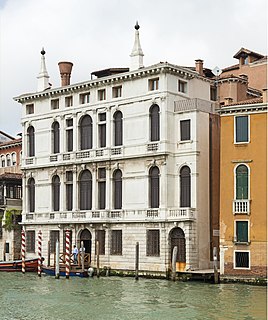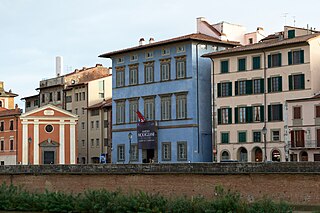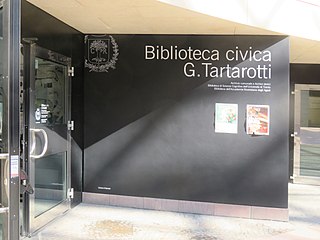
Padua is a city and comune in Veneto, northern Italy. Padua is on the river Bacchiglione, west of Venice. It is the capital of the province of Padua. It is also the economic and communications hub of the area. Padua's population is 214,000. The city is sometimes included, with Venice and Treviso, in the Padua-Treviso-Venice Metropolitan Area (PATREVE) which has a population of around 2,600,000.

Vicenza is a city in northeastern Italy. It is in the Veneto region at the northern base of the Monte Berico, where it straddles the Bacchiglione River. Vicenza is approximately 60 kilometres (37 mi) west of Venice and 200 kilometres (120 mi) east of Milan.

The province of Chieti is a province in the Abruzzo region of Italy. Its provincial capital is the city Chieti, which has a population of 50,770 inhabitants. The province has a total population of 387,649 inhabitants as of 2017 and spans an area of 2,599.58 square kilometres (1,003.70 sq mi). It is divided into 104 comuni (comune) and the provincial president is Mario Pupillo.

The Palazzo Spada is a palace located on Piazza di Capo Ferro #13 in the rione Regola of Rome, Italy. Standing very close to the Palazzo Farnese, it has a garden facing towards the Tiber river.

Palazzo Farnese is a palace in Piacenza, northern Italy.

The Palatine Gate is a Roman Age city gate located in Turin, Italy. The gate provided access through the city walls of Julia Augusta Taurinorum from the North side and, as a result, it constituted the Porta Principalis Dextra of the old town.

Padua Cathedral, or Basilica Cathedral of Saint Mary of the Assumption, is a Roman Catholic minor basilica and the cathedral located on the east end of Piazza Duomo, adjacent to the Bishop's palace, in Padua, region of Veneto, Italy. The cathedral, dedicated to the Assumption of the Virgin Mary, is the seat of the bishop of Padua. The church building, first erected as seat of a bishop of the diocese in the 4th century, has undergone major reconstructions over the centuries.

The Doge's Palace is a historical building in Genoa, northern Italy.

The Palazzo Grimani of Santa Maria Formosa is a State museum, located in Venice in the Castello district, near Campo Santa Maria Formosa.

The Royal Palace of Milan was the seat of government in the Italian city of Milan for many centuries. Today, it serves as a cultural center and it is home to international art exhibitions. It spans through an area of 7,000 square meters and it regularly hosts modern and contemporary art works and famous collections in cooperation with notable museums and cultural institutions from across the world. More than 1,500 masterpieces are on display annually.

The Giureconsulti Palace, also known as Palazzo Affari ai Giureconsulti or simply Palazzo Affari, is a 16th-century building of Milan, Italy. It is located in Piazza Mercanti, former city centre in the Middle Ages.

Palazzo Fava or Palazzo Fava-Ghisilieri is a historic palace at 2 via Manzoni in Bologna, now housing art exhibitions and the Caffè Letterario Carracci Fava. It is most notable for its three rooms of frescoes of scenes from the lives of Jason, Medea, Europa and Aeneas by Ludovico Carracci, Agostino Carracci and Annibale Carracci, commissioned in 1584 by Filippo Fava - he was introduced to them by his tailor Antonio, Agostino and Annibale's father.

The Palazzo Leoni Montanari is a late Baroque palace located in Contra’ San Corona number 25 in central Vicenza in the Veneto region of Italy. It now houses exhibition rooms, meeting places, and art collections owned by the bank Intesa Sanpaolo.

The Palazzo Giustinian Lolin is a Baroque style palace located on the Grand Canal of Venice, Italy. The present facade was designed circa 1630 by Baldassare Longhena. It is used as an exhibition venue for the Venice Biennale.

Palazzo Blu is a center for temporary exhibitions and cultural activities located in 9 Lungarno Gambacorti, in the heart of the historic center of Pisa, Italy. This museum is managed by the Fondazione Palazzo Blu, and is located in the Palazzo Giuli Rosselmini Gualandi, ancient palace restored by the Fondazione Pisa. Its name comes from the blue color uncovered during an architectural recent restoration, and attributable to the taste of Russian owners who acquired the Palazzo in the eighteenth century.

The Palazzo Loredan Cini is a Gothic-style palace located between the Palazzo Balbi Valier and the Rio San Vio on the Grand Canal, in the sestiere of Dorsoduro, Venice, Italy. The palace was formed from the amalgamation of the former Palazzo Foscari-Loredan with the adjacent Palazzo Grimani. The narrow facade on the Canal has no entrance, but the facade to the north on the Rio, has a single water door, and is connected to the adjacent campo by a bridge. The facade is decorated with two poliforas.
The Diocesan museum of Padua displays arts and artifacts belonging to the Roman Catholic Diocese of Padua; it is housed in the 15th-century former bishop's residence or Palazzo Vescovile. The building, adjacent to the Cathedral of Padua, faces the Piazza del Duomo, can in the historic center of Padua, region of Veneto, Italy.

The Biblioteca Civica Girolamo Tartarotti is the public library of Rovereto located on Corso Angelo Bettini #43, and forms part of the modern (2002) cultural center, including the Museum of Modern and Contemporary Art of Trento and Rovereto or MART, built adjacent to the 18th-century Palazzo Annona in the town of Rovereto, region of Trentino-Alto Adige, Italy.
The Palazzo Moroni is an urban aristocratic palace located on Via Porta #12 in the historic center of the upper town of Bergamo, Italy. The palace with its Baroque interior decorations and is a civic art museum, as well as used for cultural functions. The building is presently managed by the Fondazione di Palazzo Moroni in conjunction with the city after a donation by former Count Antonio Moroni.

San Nicolò is a Romanesque and Gothic-style, Roman Catholic church in Padua, region of Veneto, Italy. It stands in front of a homonymous piazza, and is adjacent to the Palazzo Meschini and Palazzo Brunelli-Bonetti.


















